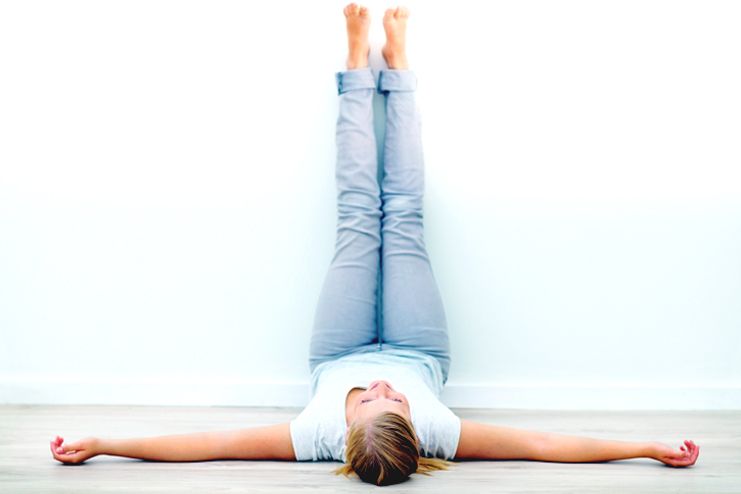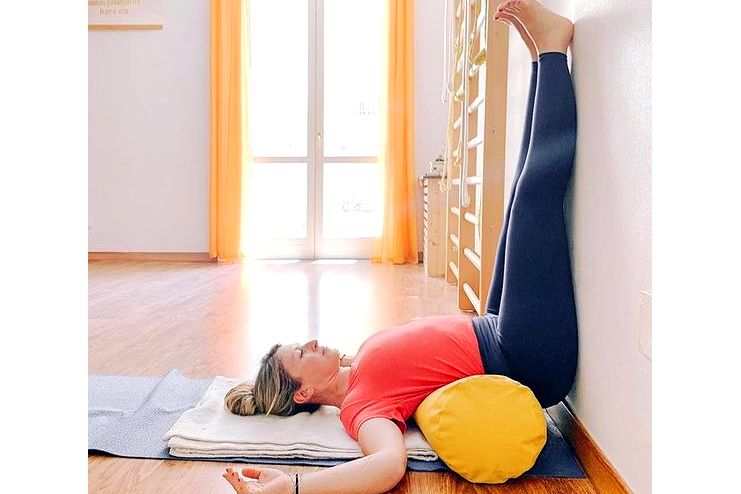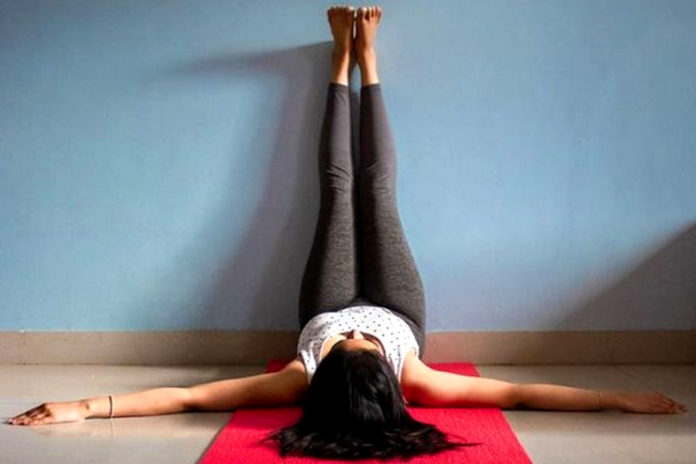Affiliate Disclaimer
Some links in this article are affiliate links. We may earn a small commission if you make a purchase through these links, at no extra cost to you. We only recommend products we find useful to our readersYoga is said to be one of the most common techniques to calm your mind and body. you do not have to be a pro but practicing certain yoga poses can bring some positive changes in your body and also help you to feel calm and relaxed. One such very simple pose that is said to have many benefits is known as the legs up the wall pose. You may be wondering that simply lying with your legs up the wall would not be able to make any difference, but let me tell you it does to mental or physical health.
It is been said by yogis around the world, that it is often the simplest postures that have the most amazing effects on our mind and body. This pose has benefited from calming the nervous system to strengthening immune health, this is an ancient posture practiced for thousands of years. Read on to find more such benefits of this pose!
About Heads up the Wall Pose – Viparita Karani


The legs-up-the-wall pose is one of the many yoga poses known as inversion poses. In this position, the upper body is inverted from its normal, upright position. This pose is known as Viparita Karani in Sanskrit. The name Viparita means “inverted” and Karani is described as “in action.”
When you perform the legs up the wall pose, then, you are in an active inversion position. With your legs above the rest of your body, in a way gravity gets to work on them which most of the time it simply cannot. This legs-up-the-wall pose can be performed even by people who aren’t able to do other inversion yoga poses.
The benefit of legs up the wall compared to any other inversion pose is that you are able to achieve the benefits of inversion without having to stress or strain your neck and head. People who suffer from chronic neck pain or any disorders of the spine in the neck region should not do shoulder stands or headstands and should be cautious about it.
Benefits of Heads Up The Wall Pose
1. It improves circulation in the lower body
Venous insufficiency is a common cause of leg swelling, it happens when your leg veins don’t effectively circulate blood from your legs back up toward your heart (R). Retention of blood in your legs is the cause of weak circulation of the blood in your legs, it can raise your chances of blood clots and, may also cause some swelling and discomfort.
Also, due to standing or sitting all day even if you don’t have chronic venous insufficiency, may limit your body’s ability to easily circulate blood back up your body. That is why the legs up the wall pose can help.
The main benefit of Viparita Karani is that it puts back the bodily fluids into circulation stored in your legs. By inverting and performing this pose, it allows the return of blood flow and also reduces the swelling in your lower legs.
2. Relieves aching muscles and joints
Performing this pose will help to relieve muscles that hurt and swollen ankles and feet. Most of the time being in a hurry or sitting at a desk for longer periods of time, your joints and spinal column can become compressed and drained of fluid, which can lead to more aches and pains.
Practicing a few minutes of heads up the wall pose can help reduce pressure on the lower back, it will also help to relieve feelings of heaviness and fatigue in the feet, legs, and hips. For all the people who suffer from swollen ankles and feet, this posture can be a great help in reducing all the swelling and discomfort.
3. Relieves Menstrual Cramps
Practicing the heads up the wall pose is beneficial for women during the menstrual cycle or premenstrual symptoms to relieve cramps, relax the abdomen, and give comfort to the lower back.
4. Supports your lymphatic systems and gives your immune system a boost
Viparita Karani or the heads up the wall pose will allow fresh, oxygenated blood to flow to the upper body, and also stimulate the flow of lymphatic fluid. Same as inversions such as headstands and shoulder stands also bring fresh blood flow and oxygen to the brain and upper body.
The lymphatic system plays a vital role in filtering and breaking down bacteria. It also filters other potentially harmful cells, but the nodes that do most of the filtering are found on the neck, armpits, stomach, and groin, which is why inverted postures like this are so important for sending fluid there. Like the blood’s circulatory system has that pump, the lymphatic system does not have it, which means it relies upon gravity and movement for it to function with their help.
Largely unknown and another important benefit of raising the legs while resting on the wall is the ability to stimulate the glymphatic system. This system is responsible for getting rid of the bacteria effectively that the lymphatic system has filtered, so it serves as an important second step in ridding the body of unwanted pathogens. That is why when the body is in a relaxed state both of these systems work much better.
5. Relaxes Neck and Shoulders
There is no pressure on the shoulders or the neck here, unlike in Sarvangasana. Viparita Karani relaxes the shoulders and the neck with the right focus on breathing while in this pose.
6. It can help you de-stress
Research shows that yoga can impact your stress hormones positively and make your mind and body feel relaxed, restorative yoga poses such as legs up the wall are intended to guide your body into a state of relaxation. People who practice this pose describe that they find holding the pose very calming. De-stressing is associated with better overall physical and mental health, and even a stronger immune system.
7. Helps activate the parasympathetic nervous system and digest the state
Resting in an inverted position encourages slow breathing, which in turn helps communicate that it’s safe to start fully relaxing the vagus nerve. This vagus nerve is a long nerve that starts in the brain and goes down through the body, which connects to the area such as the throat, heart, and diaphragm, and ends in the gut. This nerve always alerts and senses what is happening in the body and it sends messages back up to the brain, which then influences how we feel.
Breathing fast or trying to rush, the vagus nerve senses stress, and when it senses, it starts sending stress signals to the brain, and then the brain encourages the release of cortisol which is the stress hormone.
So when you fly with your legs up the wall and breathe slowly. This nerve starts to sense that you are in a calm state and sends that signal back up to the brain so that it can help you move out of the sympathetic nervous system and into a parasympathetic state that is rest and digest. (R)
8. Relaxing Pose for Runners
Practicing this pose soon after running will bring in a healthy supply of blood to the legs and the hips. That is why this pose acts as a relaxing pose for runners.
9. Relaxes Sciatic Nerve
The wall support given to the legs in this pose relaxes the legs completely. Hence Viparita Karani pose is good for tired leg muscles and even works on getting rid of any strain due to sciatica.
Does this pose help with weight loss?
For anyone to lose weight, a person must achieve or go into a calorie deficit. In simple terms, you must consume less calories from food than what your body needs in a day. Exercise can help you to increase your daily calorie needs. (R)
Though the Legs Up the Wall pose may burn few calories, it does not involve much effort and will not burn enough calories to make a great difference in your daily calorie expenditure. However, much more active or intense styles of yoga, such as power yoga, can help with weight loss.
Hence, unless you’re practicing other higher intensity exercises in your routine, or eating fewer calories than your body needs and burning it to be in a calorie deficit, the Legs Up the Wall pose is unlikely to help you burn enough calories for weight loss.
Who should adopt this pose?
Although, the heads up the wall pose or Viparita Karani is a safe and gentle posture for most people, there are certain times when it is best to not do it or use a different variation where you are not lying completely flat on your back. That is when you are pregnant if you suffer from glaucoma or untreated high blood pressure.


When you’re unable to practice this posture, another great restorative and supported Savasana with the help of cushions and blankets supporting the body is another great way to ease yourself into deep relaxation. To help stimulate the glymphatic system, you can slowly raise your feet a little on a cushion or yoga blocks, which will still bring huge benefits as an alternative to this.
How to Perform the Legs-up-the-wall Pose
The legs up the wall pose are easy to perform but it is better to take help from a yoga teacher or your yoga instructor initially so that you perform it safely without straining your neck, head, or spine.
Here’s how to perform a legs-up-the-wall pose
- Keep your props ready- Place a blanket or yoga mat on the floor, next to the wall, and use a thin pillow for your head if needed.
- Get in position- Now you need to lie down on the blanket or on your yoga mat with your buttocks elevated up toward the wall. Your tailbone should remain on the floor, with your buttocks a few inches away from the wall.
- Align- Your back and head should be simply aligned on the floor perpendicular to the wall, relaxed.
- Feel the stretch- The backs of your legs should rest against the wall, keeping your feet parallel to the floor below with your knees relaxed. You should feel a light stretch in your legs, but it should not be painful.
- Take it easy- As you hold the pose relax and breathe deeply.
- Hold- You can try to hold the pose anywhere up to two to three minutes. Once you are comfortable you can even hold it for longer, if you’d like.
- Come out of the pose slowly- When you are done, move carefully into a seated position and sit quietly and rest for at least 30 seconds.
- Relax- You need to relax your body and not rapidly come out of an inversion pose.
Also, Read: All About Restorative Yoga Poses
How Often Should You Perform Legs up the Wall?
Yoga instructors and researchers of yoga recommend that this pose is safe to do as often as once or twice a day, it can be as part of your regular yoga practice or as a stand-alone pose. The pose is done toward the end of your practice as a part of overall restorative yoga.
Precautions for Viparita Karani
While practicing Viparita Karani or heads up the wall pose. There are some points of caution you must keep in mind before you do this.
- This pose or asana is a mild inversion, and hence, it must be avoided during menstruation, especially if you have heavy bleeding. Although it can even help to relieve pain and cramps for some women.
- If you have severe eye problems like glaucoma avoid this asana.
- If you notice a sensation in your feet when you practice this pose, try bending your knees and touching the soles, bringing your heels close to the pelvis
- If you have serious back and neck problems, make sure you do this asana under the guidance of a certified yoga instructor.
Conclusion
Yoga has always proven to be beneficial to our body and certain poses like the heads up the wall pose require minimal effort. If you practice this pose daily, it may help lower stress, reduce lower back pain, and improve circulation. Hope this pose has helped you to understand all the benefits of these poses. Also one needs to take precautions before practicing. Thank you for reading.































